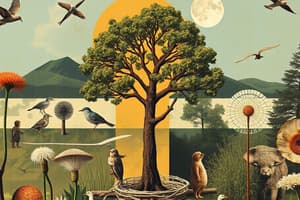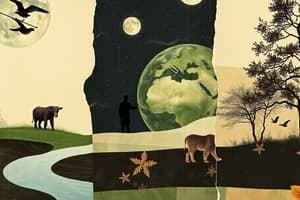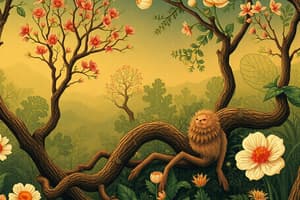Podcast
Questions and Answers
Which of the following best describes the study of ecology?
Which of the following best describes the study of ecology?
- The interactions between species in a community.
- The distribution of species across different continents.
- The cycling of nutrients in an environment.
- The interactions among organisms and between organisms and their environment. (correct)
In an ecosystem, materials cycle between:
In an ecosystem, materials cycle between:
- Living organisms and nonliving components (correct)
- Living organisms only
- Nonliving components only
- The sun and living organisms
Which level of ecological organization encompasses all other levels?
Which level of ecological organization encompasses all other levels?
- Ecosystem
- Population
- Community
- Biosphere (correct)
What is the relationship between a habitat and a niche?
What is the relationship between a habitat and a niche?
Which of the following is a key characteristic of primary succession that distinguishes it from secondary succession?
Which of the following is a key characteristic of primary succession that distinguishes it from secondary succession?
Which of the following is an example of a pioneer species that can initiate primary succession?
Which of the following is an example of a pioneer species that can initiate primary succession?
What primarily determines the type of climax community that will form in a given area?
What primarily determines the type of climax community that will form in a given area?
How does secondary succession differ from primary succession in terms of starting conditions?
How does secondary succession differ from primary succession in terms of starting conditions?
What is the role of photosynthesis in energy flow within an ecosystem?
What is the role of photosynthesis in energy flow within an ecosystem?
Which organisms occupy the lowest trophic level in an ecosystem?
Which organisms occupy the lowest trophic level in an ecosystem?
What is the primary difference between a food chain and a food web?
What is the primary difference between a food chain and a food web?
Approximately what percentage of energy is typically transferred from one trophic level to the next in an ecosystem?
Approximately what percentage of energy is typically transferred from one trophic level to the next in an ecosystem?
Why is energy lost when it is transferred from one trophic level to the next?
Why is energy lost when it is transferred from one trophic level to the next?
What is biological magnification?
What is biological magnification?
Which of the following is a potential benefit of adopting a largely vegetarian diet from an ecological perspective?
Which of the following is a potential benefit of adopting a largely vegetarian diet from an ecological perspective?
What is the significance of biogeochemical cycles in maintaining the balance of ecosystems?
What is the significance of biogeochemical cycles in maintaining the balance of ecosystems?
What role does transpiration play in the water cycle?
What role does transpiration play in the water cycle?
How do human activities generally impact the water cycle?
How do human activities generally impact the water cycle?
What is the role of photosynthesis in the carbon cycle?
What is the role of photosynthesis in the carbon cycle?
How is carbon returned to the atmosphere?
How is carbon returned to the atmosphere?
What is one of the major results of increased atmospheric carbon dioxide?
What is one of the major results of increased atmospheric carbon dioxide?
What does the term 'biodiversity' refer to?
What does the term 'biodiversity' refer to?
Which of the following is NOT a major cause of biodiversity loss?
Which of the following is NOT a major cause of biodiversity loss?
Why is genetic diversity within a species important?
Why is genetic diversity within a species important?
What does it mean when Earth is referred to as an ecosystem?
What does it mean when Earth is referred to as an ecosystem?
What is considered the Earth's source of energy?
What is considered the Earth's source of energy?
What defines a population?
What defines a population?
What defines a community?
What defines a community?
What would be an example of an ecosystem?
What would be an example of an ecosystem?
What would be a characteristic of the biosphere?
What would be a characteristic of the biosphere?
What is considered an organism's niche?
What is considered an organism's niche?
What is an organism's habitat?
What is an organism's habitat?
If an ecosystem is seeing a sequence of changes in the species composition over time, what is this an example of?
If an ecosystem is seeing a sequence of changes in the species composition over time, what is this an example of?
If no previous community previously existed in an environment, what does this refer to?
If no previous community previously existed in an environment, what does this refer to?
What describes secondary succession?
What describes secondary succession?
What is the source of energy flow?
What is the source of energy flow?
What organisms form the lowest trophic level?
What organisms form the lowest trophic level?
What is biomass defined as?
What is biomass defined as?
What do biogeochemical cycles consist of?
What do biogeochemical cycles consist of?
What is Earth's atmosphere moved to land?
What is Earth's atmosphere moved to land?
If the amount of species is decreasing globally, what happens?
If the amount of species is decreasing globally, what happens?
What term describes all the physical, chemical, and biological factors that contribute to an organism's health and reproductive success within an ecosystem?
What term describes all the physical, chemical, and biological factors that contribute to an organism's health and reproductive success within an ecosystem?
What is the correct order of the levels of ecological organization, from narrowest to broadest?
What is the correct order of the levels of ecological organization, from narrowest to broadest?
Lichens are commonly the first organisms to colonize barren rock during primary succession. What makes them so effective as pioneer species?
Lichens are commonly the first organisms to colonize barren rock during primary succession. What makes them so effective as pioneer species?
How might a forest fire facilitate secondary succession in an ecosystem?
How might a forest fire facilitate secondary succession in an ecosystem?
In an ecosystem, if the producer trophic level contains 10,000 kcal of energy, approximately how much energy will be available to the tertiary consumers?
In an ecosystem, if the producer trophic level contains 10,000 kcal of energy, approximately how much energy will be available to the tertiary consumers?
Which statement regarding energy transfer in ecosystems is most accurate?
Which statement regarding energy transfer in ecosystems is most accurate?
What is the primary reason that top-level predators, like sharks or eagles, are most threatened by the effects of biological magnification?
What is the primary reason that top-level predators, like sharks or eagles, are most threatened by the effects of biological magnification?
If humans universally adopted a vegetarian diet, what would be the most likely ecological consequence?
If humans universally adopted a vegetarian diet, what would be the most likely ecological consequence?
What is the primary role of decomposers in biogeochemical cycles?
What is the primary role of decomposers in biogeochemical cycles?
Deforestation is known to disrupt the water cycle. What is the most direct impact of deforestation on this cycle?
Deforestation is known to disrupt the water cycle. What is the most direct impact of deforestation on this cycle?
Why are forests often referred to as carbon sinks?
Why are forests often referred to as carbon sinks?
What is the most significant threat posed by the increased acidity of oceans due to higher atmospheric carbon dioxide levels?
What is the most significant threat posed by the increased acidity of oceans due to higher atmospheric carbon dioxide levels?
Why is the maintenance of genetic diversity within a species crucial for its long-term survival?
Why is the maintenance of genetic diversity within a species crucial for its long-term survival?
What is the likely consequence of the current rate of species extinction, as estimated by scientists?
What is the likely consequence of the current rate of species extinction, as estimated by scientists?
What is a potential impact of the melting of the Greenland ice sheet on coastal regions?
What is a potential impact of the melting of the Greenland ice sheet on coastal regions?
Flashcards
What is Ecology?
What is Ecology?
The study of interactions among organisms and their environment.
Energy in an ecosystem
Energy in an ecosystem
Energy initially comes from the sun, captured by green plants, and then transferred from organism to organism.
What is the Biosphere?
What is the Biosphere?
The part of Earth where life exists, consisting of many ecosystems.
What is a Population?
What is a Population?
Signup and view all the flashcards
What is a Community?
What is a Community?
Signup and view all the flashcards
What is an Ecosystem?
What is an Ecosystem?
Signup and view all the flashcards
What is a Niche?
What is a Niche?
Signup and view all the flashcards
What is a Habitat?
What is a Habitat?
Signup and view all the flashcards
What is Ecological Succession?
What is Ecological Succession?
Signup and view all the flashcards
What is Primary Succession?
What is Primary Succession?
Signup and view all the flashcards
What are Pioneer Species?
What are Pioneer Species?
Signup and view all the flashcards
What is a Climax Community?
What is a Climax Community?
Signup and view all the flashcards
What is a Temperate Deciduous Forest?
What is a Temperate Deciduous Forest?
Signup and view all the flashcards
What is a Temperate Grassland?
What is a Temperate Grassland?
Signup and view all the flashcards
What is a Desert?
What is a Desert?
Signup and view all the flashcards
What is a Taiga?
What is a Taiga?
Signup and view all the flashcards
What is a Tropical Rain Forest?
What is a Tropical Rain Forest?
Signup and view all the flashcards
What is Secondary Succession?
What is Secondary Succession?
Signup and view all the flashcards
What is Photosynthesis?
What is Photosynthesis?
Signup and view all the flashcards
What is a Trophic Level?
What is a Trophic Level?
Signup and view all the flashcards
Who are Producers?
Who are Producers?
Signup and view all the flashcards
Who are Consumers?
Who are Consumers?
Signup and view all the flashcards
Who are Herbivores?
Who are Herbivores?
Signup and view all the flashcards
Who are Carnivores?
Who are Carnivores?
Signup and view all the flashcards
Who are Omnivores?
Who are Omnivores?
Signup and view all the flashcards
Who are Decomposers?
Who are Decomposers?
Signup and view all the flashcards
What is a Food Chain?
What is a Food Chain?
Signup and view all the flashcards
What is a Food Web?
What is a Food Web?
Signup and view all the flashcards
What is Biomass?
What is Biomass?
Signup and view all the flashcards
What is Biological Magnification?
What is Biological Magnification?
Signup and view all the flashcards
What are Biogeochemical Cycles?
What are Biogeochemical Cycles?
Signup and view all the flashcards
What is the Water Cycle?
What is the Water Cycle?
Signup and view all the flashcards
What are Aquifers?
What are Aquifers?
Signup and view all the flashcards
What is the Carbon Cycle?
What is the Carbon Cycle?
Signup and view all the flashcards
How is carbon removed?
How is carbon removed?
Signup and view all the flashcards
How is carbon returned?
How is carbon returned?
Signup and view all the flashcards
Human activities increasing atmospheric CO2.
Human activities increasing atmospheric CO2.
Signup and view all the flashcards
What are the results of increased atmospheric CO2?
What are the results of increased atmospheric CO2?
Signup and view all the flashcards
What is Biodiversity?
What is Biodiversity?
Signup and view all the flashcards
What are Mass Extinctions?
What are Mass Extinctions?
Signup and view all the flashcards
What are the causes of biodiversity loss?
What are the causes of biodiversity loss?
Signup and view all the flashcards
Study Notes
- Ecology, the Environment, and Us are important aspects of Biology
Earth as an Ecosystem
- Ecology studies interactions among organisms and their environment
- Energy comes from the sun
- Green plants capture solar energy and transfer it to organisms.
- Materials cycle between organisms and living / non-living components because there is no other source of new materials
Biosphere
- Biosphere: The part of Earth that supports life and consists of many ecosystems
- Population: Includes all individuals of the same species in an area
- Community: living species in an ecosystem that can potentially interact.
- Ecosystem: Organisms in a specific geographic area, together with their physical environment
- Niche: An organism's role in the ecosystem is determined by physical, chemical, and biological factors
- Habitat: A place where an organism lives, and is a part of the overall niche
Ecological Succession
- This is the sequence of changes in the species composition of a community over time
- Two types of succession are: Primary and Secondary
Primary Succession
- Occurs where no previous community existed and not even soil is present at the beginning
- Pioneer species: First living things, such as lichens, that invade an area to begin soil formation
- Climax community: Temperature, rainfall, nutrient availability, and exposure to sun and wind determine which kind of the climax community forms. This occurs after pioneer species
Secondary succession
- Occurs when an existing community is cleared by fire or volcanic eruption
- Soil is present at the start
- Initial invaders include grasses, weeds, and shrubs
Energy Flow
- Energy is supplied by the sun, which plants and algae trap and transform into glucose using photosynthesis
- Animals then eat the plants
- Photosynthesis uses the sun's energy to convert CO₂ and H₂O to carbohydrates, releasing O₂
- Trophic level: Feeding level between organisms
- Producers: Photosynthesizers like plants and algae, which start with CO₂ and form the lowest trophic level
- Consumers: Use energy stored by producers and form higher trophic levels
Energy Flow - Consumers By Food Source
- Herbivores: Consumers that eat only plants, noted as 1° consumers
- Carnivores: Consumers that feed on herbivores (2° consumers) or other carnivores, also known as meat eaters (3° consumers)
- Omnivores: Consumers that eat both plants (1°) and animals (2° and 3° consumers)
- Decomposers: Consume dead organic material for energy and release inorganic material for producers
Food Chains and Food Webs
- Food chain is a simplistic, linear sequence
- Food web represents more realistic patterns and includes many organisms that eat at several trophic levels
Energy Transfer
- Energy is lost when transferred from one trophic level to the next
- About 10% of energy available at one trophic level is transferred to the next
- Biomass, or the dry weight of an organism, is the only energy converted and available to the next higher trophic level
Biological Magnification
- Biological magnification is the concentration of nondegradable chemicals increases in organisms at successive trophic levels
World Hunger
- World hunger: Only about 10% of the energy captured by one trophic level is available to the next
- Less land would cultivated and more people could be fed if people adopted a vegetarian diet
Biogeochemical Cycles
- Earth's resources are limited and would be depleted without nature's recycling
- Materials move through transfers from living to nonliving systems and back again in recurring pathways
Water Cycle
- Water moves from the atmosphere to land as precipitation and returns via evaporation and plant transpiration
- Large amounts of water are temporarily stored in living things
- Human activities such as deforestation, altered runoff patterns, freshwater overuse, polar ice loss, and contamination disrupt the water cycle
Carbon Cycle
- Carbon moves from the environment into living things and back
- Living organisms need carbon to build molecules such as: Proteins, Carbohydrates, Fats and Nucleic acids
- Carbon dioxide (CO₂) is removed from the environment by producers during photosynthesis via sunlight
- Carbon in organic molecules then moves through the food web
- Carbon is returned to the atmosphere as CO₂ during cellular respiration
- Some carbon is sequestered in wood of trees, limestone, and fossils fuels
- Decomposition of dead plants and animals, erosion of limestone, and combustion release sequestered carbon
- Human activities increase CO₂ levels in the atmosphere through burning fossil fuels and deforestation
- Increased atmospheric CO₂ results in global warming and increased ocean acidity
Biodiversity
- Biodiversity refers to the species richness, including the number and abundance of species in a given area.
- Biodiversity is decreasing globally
- Habitat destruction and climate change are largely responsible for the decline
- Human disturbances lead to changes in biodiversity
Mass Extinctions
- Mass extinctions involve the loss of many species. These have occurred in the past, but never before due to human involvement
- Scientists estimate that species are currently being lost at a rate of 100 per day or more
Causes of Biodiversity Loss
- Habitat destruction is a cause
- The introduction of Alien species is a cause
- Overexploitation is a cause
Why Biodiversity Loss Matters
- Why should we care about the loss of biodiversity?
- Genetic diversity is useful to crossbreeding and genetic engineering
- Having only one variety of a plant predominates, changing conditions might completely wipe out that food source
- Plants may provide new drugs
- Organisms are critical to properly functioning biogeochemical cycles
- Since life is interrelated, losing one plant or animal may unexpectedly impact others
Studying That Suits You
Use AI to generate personalized quizzes and flashcards to suit your learning preferences.




